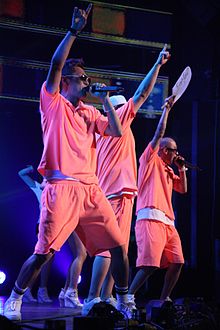Korean hip-hop
English-speaking Korean diaspora artists such as Drunken Tiger, Epik High's Tablo, Swings, Jay Park, and San E have included English lyrics in their raps.MC Sniper, an underground rapper and the founder of the hip-hop crew Buddha Baby, is known for his early use of traditional musical and religious elements including the 12-stringed zither (gayageum) and the transverse bamboo flute (daegeum) and the Buddhist wooden percussion (moktak) in his productions.In April 2016, "Eung Freestyle" produced by DPR crew which mainly used the Korean instrument gayageum attracted global popularity after being released on YouTube.Servers such as Chollian, HiTel, Daum, Nate, and Naver provided free web-based emails, messaging services, and forums.PC communities created in these servers such as BLEX, Dope Soundz, and Show N Prove (SNP) worked as a place to share Korean translations of English lyrics, swap imported cassette tapes and CDs, and discuss the meaning of hip-hop in their lives.First generation artists such as Verbal Jint, P-Type, Defconn (SNP), and Garion (BLEX) actively participated in these online communities.Many of these online community users started holding a monthly offline meeting called jeongmo to discuss hip-hop music and perform their works, leading to the development of local scenes.The winners being JUSTHIS, Groovy Room, BeWhy's “Forever”, Nucksal's The God of Small Things, and Jay Park respectively.Widely known for its prestigious art/music college and liberal atmosphere, Hongik University contributed to the emergence of youth culture including hip-hop music in the area.Master Plan (MP), originally an indie rock club located in the greater Hongdae area, is often regarded as the birthplace of underground Korean hip-hop.However, criticism against the authenticity of the TV show resulted in the emergence of independent YouTube channels operated by hip-hop labels and musicians.Starting in 2012, hip-hop audition programs such as Show Me the Money, Unpretty Rapstar, and High School Rapper became widely popular in Korea.Also, with the success of SMTM, underground rappers who negatively thought of signing with labels started considering the idea due to the promise of rising profits in the genre.Social media platforms such as YouTube and SoundCloud has been one of the main channels Korean hip-hop artists present their works and communicate with its fans.Song Mino of Winner was active as an underground rapper alongside Zico from Block B and was the runner-up of the fourth season of SMTM.[25][26][27] Successful collaborations include "Some," a 2014 song by Soyou of girl group Sistar, R&B singer Junggigo, and rapper Lil Boi, that was Billboard's K-pop Hot 100's longest running #1 hit of 2014;[28] "A Midsummer Night's Sweetness," a 2014 collaboration of After School's Raina and rapper San E, that topped ten Korean music charts shortly after its debut and went on to win several major year-end awards;[29][30][31][32] and "I," a 2015 song by Girls' Generation's Taeyeon featuring rapper Verbal Jint, that topped eight Korean music charts after its release.[1][5][36] Hyun Jin-young, a rapper who debuted the following year with the album, New Dance, is considered to be the first Korean hip-hop artist.[1][37][38] The debut of Seo Taiji and Boys in 1992 with the song, "Nan Arayo" (난 알아요, "I Know") marked a revolution in Korean popular music.[2][39] Other popular groups who helped spread hip-hop into the Korean mainstream in the early 1990s include Deux and DJ DOC.[44] hip-hop duo Jinusean, who were signed to former Seo Taiji and Boys member Yang Hyun-suk's new label YG Entertainment, also found mainstream success during this period with their songs "Tell Me" and "A-Yo," among others.[58][59][60] Viewer ratings for SMTM seasons 4,5 and 6 continued to exceed 2%, which is exceptionally high for a cable TV channel program.[61] SMTM worked as a publicity opportunity for previously unknown rappers such as C Jamm, Black Nut, Bewhy and Woo Won-jae.[62][63] Influenced by Big Sean's hip-hop track “Control”, in which Kendrick Lamar's verse called out a handful of the new rappers in the U.S. music industry, Korean artists started sending disses in every direction with harsh lyrics.Eventually, more than 20 rappers including Simon Dominic, Ugly Duck, and Deep Flow participated in the “control diss war” before it ended within one week.This music competition focused on female rappers including Season 1 runner-up Jessi, who the following year starred in KBS 2TV's Sister's Slam Dunk.Illionaire Records established Ambition Musik in 2016 by signing 3 artists who gained popularity through SMTM (Hash Swan, Keemhyoeun, ZENE THE ZILLA).[67] As these hip-hop labels and sub-labels were getting bigger, they were continuously making their voices louder against the large K-pop agencies that have been dominating the Korean music industry since the 2000s.Tiger JK of Drunken Tiger and his wife Yoon Mi-rae, then a member of a Korean-American hip-hop/R&B group called Uptown, formed the Movement Crew, the influential hip-hop community that gave rise to groups like Dynamic Duo, Leessang, and Epik High, who collectively planted the localized hip-hop firmly in the mainstream pop music in South Korea.Many Western people who don't speak Korean now know the phrase ‘It G Ma’.” The following year, Eung Freestyle (응프리스타일) performed by DPR Live, Sik-K, Punchnello, Owen Ovadoz, and Flowsik gained attention with the help of Youtube's Music's Ad Campaign.Dance crew called "Rhythm touch" was initially influential,as they were back dancers for singers Insooni and Kim Wan-sun.

Hip hopBreakdancingKorean wavehip-hopSouth Korean popular musicSouth Koreagraffititurntablismb-boyingKoreanAfrican-AmericanDrunken TigerEpik HighSwingsJay ParkGarionConfucianBill StaxSeo Taiji and BoysMC SnipergayageumKorean balladspentatonic scalesJUSTHISGroovy RoomNucksalHongdaeHongik UniversityShow Me the MoneyUnpretty RapstarHigh School RapperCJ E&MYouTubeSoundCloudH1ghr MusicSeo TaijiJinuseanBig BangBlock BOlltiiSistarJunggigoLil BoiBillboardK-pop Hot 100A Midsummer Night's SweetnessAfter SchoolGirls' GenerationTaeyeonVerbal Jint1988 Seoul OlympicsKorean diasporaHyun Jin-youngDJ DOCI KnowYang Hyun-sukYG EntertainmentKorean languageDynamic DuoTaxi DriverShoeboxLeessangAsura BalbaltaC JammBlack NutWoo Won-jaeLee Young-jiBig SeanControlKendrick LamarKBS 2TVSister's Slam DunkAsh IslandAmbition MusikKorea FoundationHash SwanCha Cha MaloneTiger JKYoon Mi-raeCoachellaIllionaire RecordsAmoeba CultureKeith ApeDPR LiveFlowsikRoc NationItaewonInsooniKim Wan-sunBattle of the YearKorean Tourism OrganizationR-16 KoreaSoompiAllkpopThe Korea HeraldKoreAmThe Korea TimesThe HankyorehKorean Culture and Information ServiceAegukgaAegukkaNorth KoreaTraditionalInstrumentsPansoriPungmulNongakShinawiHyangakDangakJeongakRevolutionary OperaBillboard K-Pop Hot 100List of K-pop on the Billboard chartsAlbumsTimelineGaon Singles ChartGaon Albums ChartList of North Korean musiciansList of South Korean musiciansList of female K-pop artistsList of male K-pop artistsList of South Korean idol groupsList of music festivals in South KoreaMusic programs of South KoreaKorean ballad